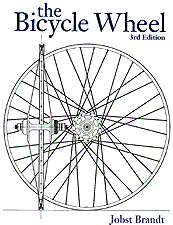

|
Subject: Stress Relieving Spokes
From: Jobst Brandt
Date: November 29, 1999
It appears that the process of stress-relieving is obscure to many if not most people, because after seeming to have made it clear, comments still surface. Spokes are cold formed from wire that is (at least DT) as hard and work hardened as it can become. Tensioning does not further harden spokes, there being no plastic deformation. Besides, wire ductility is important both in forming spokes and in use.
The coiled wire from which spokes are made is straightened by running it first between rollers staggered in X and then in Y, the wire moving in the Z direction. Reverse bending acts as a degausser, having ever diminishing excursions that affect ever shallower depths of the wire. This stress-relieves the wire while removing the curl of being shipped in a coil. If it had no curl, releasing its free end on the spool would allow it to uncoil explosively into a huge bird's nest.
Wire is cut into suitable lengths, the first operation being to cold-form a spoke head onto one end with one axial blow of a die, after which the spoke is cut to a specific length before rolling the thread and bending a 100-degree elbow.
Threads, head, and elbow contain metal that was plastically deformed (beyond yield) as well as metal that was elastically deformed, each having elastic memory. In these transitions, parts that yielded and ones that did not are in conflict, each wanting to return to or stay in a different shape. This is why a spoke bent by hand springs back only partially when released.
On lacing spokes into a wheel, elbows are often additionally bent (brought to yield), thus remaining at or exceeding yield stress during tensioning. Threads also have internal tensile stress besides local compressive stress at the threads. The thread core is already in tension from the lengthening effect of thread rolling, and its stress only increases with tensioning.
Therefore, spokes in a newly built wheel have locations where stress is near yield, some more so than others. Because fatigue endurance of a metal at or near the yield stress is short, cyclic loads in such spokes will cause failures at high- stress points. In normal use, a wheel only unloads spokes, but with spokes near yield, even these stress cycles readily cause fatigue failures. Only the lightest riders on smooth roads might be spared failures with a wheel whose spokes have not been stress-relieved.
![]()
![]()
Stress relieving to relax these high stress points is accomplished by over-stressing them in order to erase their memory. It is not done to bed the spokes into the hub, as is often stated. Bedding-in occurs sufficiently from tension. However, stretching spoke pairs with a strong grasp at mid-span, can momentarily increased tension by 50% to 100%. Because spokes are usually tensioned no higher than 1/3 their yield stress, this operation has no effect on the spoke as a whole, affecting only the small high stress zones where spokes are near yield. By stretching them, these zones relax below yield by as much as the overload.
Stress relieving with a light grasp of spoke pairs is worthless, as is bouncing the wheel or bending it in a partially opened drawer. Pressing axially on the hub, while supporting the rim, requires a force larger than is manually possible but is effective for spoking machines (except the left side rear spokes that would collapse the rim). Another not recommend method, is laying the wheel on the floor and walking on it with tennis shoes, carefully stepping on each pair of crossed spokes. The method works but bends the rim and is difficult to control.
It is STRESS RELIEVING! Even though people insist on calling it pre-stressing or seating-in. The wheel is already prestressed when tensioned.
![]()

![]()
More Articles by Jobst Brandt
Next: Tied and Soldered Wheels
Previous: Reusing Spokes
![]()
![]()
Last Updated: by John Allen